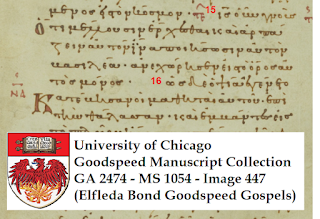Near the end of John 6:15 – following John’s account of the feeding of the 5,000 – there is an interesting variant-unit: did John write that Jesus withdrew again (ἀνεχώρησεν πάλιν) to the mountain by himself, or that Jesus withdrew (ἀνεχώρησεν) (without “again”) to the mountain by himself, or that Jesus “fled again” φεύγει πάλιν) to the mountain by himself?
John does not use ἀνεχώρησεν anywhere else, so perhaps
there is something to be said in favor of φεύγει: the idea is that copyists changed the wording of Jesus’ movement to avoid giving the impression that Jesus was running away like Brave Sir
Robin. On the other hand, John
does not use φεύγει anywhere else, either.
Constantine von Tischendorf was willing to let Codex Sinaiticus
overrule all other Greek manuscripts in existence in John 6:15, in his eighth
edition of the Greek New Testament.
Scholars less entranced with À have not concurred, arguing (as Metzger reports in
his Textual Commentary) that φεύγει
originated as a Western reading. It had
to be introduced as a sort of paraphrase fairly early, inasmuch as it is
supported by Tertullian, De Rebaptismate,
Ambrose, Jerome (who placed fugit in
the Vulgate, agreeing with several Old Latin copies) and Augustine. (Tertullian’s reference is not airtight,
however: in On
Idolatry XVIII, he simply says that Christ “shrank back from being made a
king,” without explicitly quoting John 6:15.)
The Curetonian Syriac, interestingly, supports a conflate
reading: fled and withdrew again.
 Readers of the Nestle-Aland Novum Testamentum Graece compilation would never detect that the
reading found in the Byzantine Text, W, and the Peshitta exists: the N-A apparatus mentions the reading in À but not the reading of most manuscripts – an omission
that is difficult to explain except as an effect of the editors’ pro-Alexandrian
bias. The UBS apparatus doesn’t mention
the non-inclusion of πάλιν either; nor does they Tyndale House GNT’s apparatus.
Readers of the Nestle-Aland Novum Testamentum Graece compilation would never detect that the
reading found in the Byzantine Text, W, and the Peshitta exists: the N-A apparatus mentions the reading in À but not the reading of most manuscripts – an omission
that is difficult to explain except as an effect of the editors’ pro-Alexandrian
bias. The UBS apparatus doesn’t mention
the non-inclusion of πάλιν either; nor does they Tyndale House GNT’s apparatus.
The non-original reading φεύγει is more interesting than it looks – not
only because it was temporarily favored by a leading textual critic in the
1800s, but because it reveals that retro-translation sporadically affected the
Greek text in the exemplar of the opening chapters of John in Sinaiticus – the same
sort of Western phenomenon that has unfortunately affected the NIV 2011’s
base-text of Mark
1:41.

2 comments:
Chrysostom has “departed again” proper on his text of John 6:15, but interestingly enough he has “fled” in one of his homilies in Matthew. I guess the latter was just the way people at that time quoted the verse loosely from memory. Another detail that I found interesting was the fact that Cyril of Alexandria repeated the content of this verse several times in his commentary on the sixth chapter of the gospel of John, and the “again” never appeared. I find fascinating the fact that Cyril’s text at times departs from the Alexandrian text as we know it today.
Remember that these early chapters of John in Aleph are "Western," that is, aligned with the Old Latin manuscripts. This is a good example of that.
Post a Comment